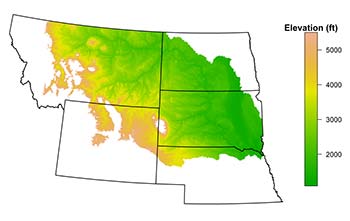UW Professor Receives $8 Million Federal Grant to Monitor Snowpack, Soil Moisture in Upper Missouri River Basin
Published October 02, 2020

The University of Wyoming has received a five-year, $8 million grant from the U.S. Army Corps of Engineers to establish a network of stations to monitor snowpack and soil moisture throughout the plains areas of the Upper Missouri River Basin. The goal is to help predict and prevent future flooding in these areas.
The grant announcement was made Sept. 28 by the U.S. Department of Defense. The grant runs through Sept. 27, 2025.
Ginger Paige, a professor of water resources in the UW Department of Ecosystem Science and Management, is the principal investigator (PI) for the Wyoming component of the project. The $8 million Wyoming contract is part of a larger $48.2 million project that is a collaboration with the other states in the Upper Missouri River Basin.
“With the significant flooding in 2011 and 2019 in the Upper Missouri River Basin, it was clear that there was a need for improved ‘total water’ monitoring,” Paige says. “Frozen and saturated soil, and significant snowpack on the Upper Missouri River Basin plains were major contributors to flooding in 2011 and 2019.”
States that comprise the Upper Missouri River Basin are Montana, Nebraska, North Dakota, South Dakota and Wyoming. The areas targeted by this project are the plains of the Upper Missouri River Basin upstream of Sioux City, Iowa, and at areas up to 5,500 feet in elevation, Paige says.
The U.S. Army Corps of Engineers in Omaha, Neb., is overseeing the project, contracting with the five states to install and retrofit the mesonet weather stations. A mesonet is a network of environmental monitoring stations.
The stations in Wyoming will be installed in the Big Horn and Powder River basins. The specific locations for the monitoring stations have not yet been established, Paige says.
These stations will monitor “total water” within the “plains” areas of the Upper Missouri River Basin, she says. This monitoring entails precipitation (rain and snow), wind speed and direction, solar radiation, air temperature, snow depth and soil moisture.
“These data are important for improved monitoring and modeling of snow and run-off for river forecasting, drought prediction and reservoir management,” she says.
The improved data will be available for use in water management by the U.S. Army Corps of Engineers, agriculture, emergency management operations, the general public, natural resources, research and water resources.
“The University of Wyoming has won an important contract to keep communities safe,” says U.S. Sen. John Barrasso, chairman of the Senate Committee on Environment and Public Works. “Wyoming now has critical, additional resources to fund a new network of stations to monitor snowpack and soil moisture. These stations are essential for predicting floods and preparing for them.
“Floods and droughts do tremendous property damage and, tragically, can cost lives. That’s why I worked to create and support this flood prevention program in recent water infrastructure laws,” Barrasso continues. “I am thankful to the Trump administration for awarding this important contract to the University of Wyoming.”
The final network of monitoring stations will cover about a quarter million square miles with over 500 weather stations, which equates to a station every couple of dozen miles. Currently, some existing stations are being retrofitted, Paige says.
Paige says she will work with the Wyoming Mesonet in the collection and dissemination of the data from the Wyoming monitoring stations. Additionally, there will be significant collaboration with the PIs and mesonets from the other Upper Missouri River Basin states.
While no other UW faculty members are currently involved in the project, Paige expects some UW graduate and undergraduate students will eventually work on this effort.
The current contract does not explicitly contain a public outreach component. However, Paige says there certainly will be a large outreach component as the network is developed and data become available.
“I have an extension appointment at UW and will make certain that there is an outreach component targeting citizen scientists, teachers and students, and water resource stakeholders across the state and region,” Paige says. “Most of these opportunities will be developed over the next few years.”

